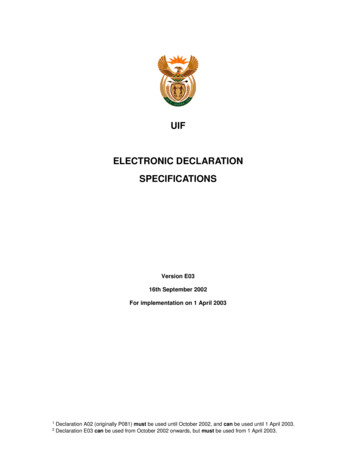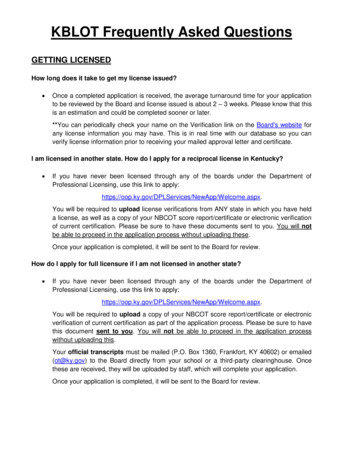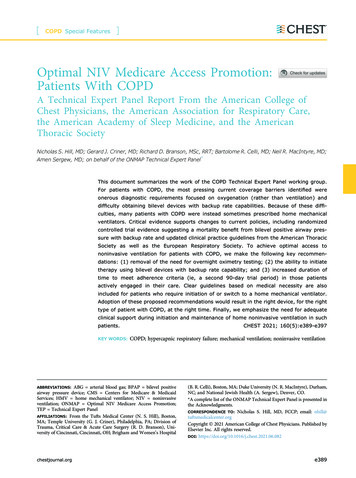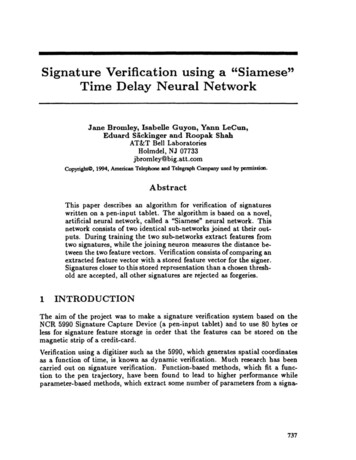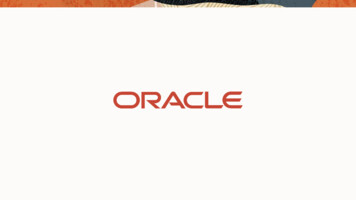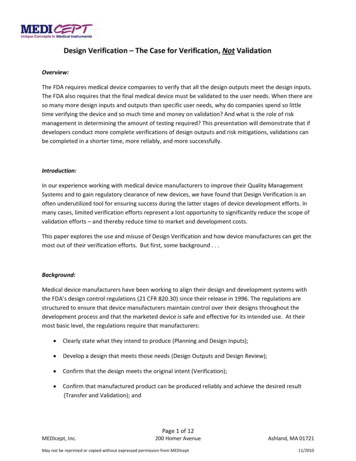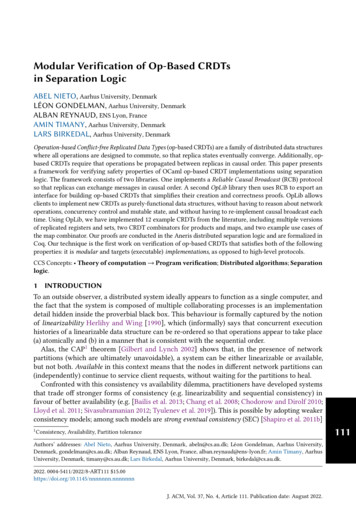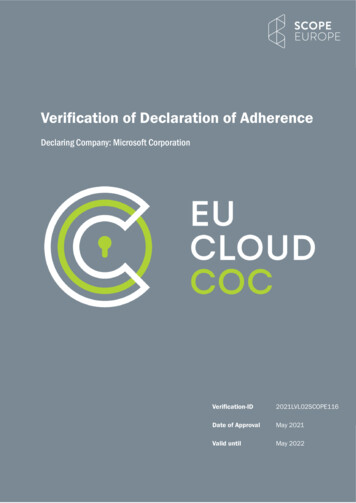
Transcription
Verification of Declaration of AdherenceDeclaring Company: Microsoft CorporationVerification-ID2021LVL02SCOPE116Date of ApprovalMay 2021Valid untilMay 2022
Table of Contents1Verification against v2.11 of the EU Cloud CoC42List of declared services42.1Microsoft 52.1.4Storage52.1.5Databases52.1.6Developer Tools52.1.7Analytics62.1.8AI Machine Learning62.1.9Internet of gement and Governance 1.16Mixed Reality73Verification Process - Background73.1Approval of the Code and Accreditation of the Monitoring Body73.2Principles of the Verification Process73.3Multiple Safeguards of Compliance83.4Process in Detail83.4.1Levels of Compliance9SCOPE Europe sprlManaging DirectorING BelgiumRue de la Science 14Jörn WittmannIBAN BE14 3631 6553 48831040 BRUSSELSSWIFT / BIC: BBRUBEBBhttps://scope-europe.euCompany Register: 0671.468.741info@scope-europe.euVAT: BE 0671.468.7412 14
3.4.23.54Final decision on the applicable Level of ComplianceTransparency about adherenceAssessment of declared services by Microsoft (see 2.)1011114.1Fact Finding114.2Selection of Controls for in-depth assessment124.3Examined Controls and related findings by the Monitoring Body124.3.1Examined Controls124.3.2Findings by the Monitoring Body125Conclusion136Validity14Verification of Declaration of Adherence3 14
1 Verification against v2.11 of the EU Cloud CoCThis Declaration of Adherence was against the European Data Protection Code of Conduct for CloudService Providers (‘EU Cloud CoC’)1 in its version 2.11 (‘v2.11’)2 as of December 2020.Originally being drafted by the Cloud Select Industry Group3 (‘C-SIG’) the EU Cloud CoC, at that timebeing called C-SIG Code of Conduct on data protection for Cloud Service Providers, the Code wasdeveloped against Directive 95/46/EC4 incorporates feedback by the European Commission as wellas Working Party 29. Following an extensive revision of earlier versions of Code and further developingthe substance of the Code v2.11 and its provisions has been aligned to the European General DataProtection Regulation (‘GDPR’)5.2 List of declared services2.1 Microsoft Azure6Microsoft Azure is a cloud computing platform for building, deploying and managing cloud servicesthrough a global network of Microsoft and third-party managed datacenters. It supports both Platformas a Service (PaaS) and Infrastructure as a Service (IaaS) cloud service models, offers more than 200services, and enables hybrid solutions that integrate cloud services across multiple clouds, on-premises, and at the edge. Azure supports many customers, partners, and government organizations thatspan across a broad range of products and services, geographies, and industries. Microsoft Azure isdesigned to meet their security, confidentiality, and compliance requirements.7 As comprising of:2.1.1 ComputeApp ServiceAPI AppsMobile AppsWeb AppsStatic Web AppsAzure Arc Enabled ServersAzure FunctionsAzure Service FabricAzure VM Image BuilderAzure VMware SolutionBatchCloud ServicesVirtual Machines (incl. Reserved Instances)Virtual Machines Scale SetsWindows Virtual the-code3 d-select-industry-group-code-conduct4 L/?uri CELEX:31995L00465 L/?uri CELEX:32016R06796 https://www.azure.com/7 NOTE: The content for the service description has been provided by the CSP and does not reflect any opinionof or assessment by the Monitoring Body.12Verification of Declaration of Adherence4 14
2.1.2 ContainersAzure Arc Enabled KubernetesAzure Kubernetes Service (AKS)Azure Red Hat OpenShiftContainer InstancesContainer Registry2.1.3 NetworkingApplication GatewayAzure BastionAzure DDoS ProtectionAzure DNSAzure ExpressRouteAzure FirewallAzure Firewall ManagerAzure Front DoorAzure Internet AnalyzerAzure Peering ServiceAzure Private LinkAzure Public IPAzure Web Application FirewallContent Delivery NetworkLoad BalancerNetwork WatcherTraffic ManagerVirtual NATVirtual NetworkVPN GatewayVirtual WAN2.1.4 StorageAzure Archive StorageAzure BackupAzure Data BoxAzure Data Box Edge and GatewayAzure Data Lake Storage Gen1Azure File SyncAzure HPC CacheAzure Import/ExportAzure NetApp FilesAzure Site RecoveryAzure StorageArchiveBlobs (incl. Data Lake Storage Gen2)Disks (incl. Managed Disks)FilesQueuesTables2.1.5 DatabasesAzure API for FHIRAzure Cache for RedisAzure Cosmos DBAzure Database for MariaDBAzure Database for MySQLAzure Database for PostgreSQLAzure Database Migration ServiceAzure DatabricksAzure SQLAzure Synapse AnalyticsStorSimple2.1.6 Developer ToolsAzure App ConfigurationAzure DevTest LabsAzure for EducationAzure Lab ServicesSCOPE Europe sprlManaging DirectorING BelgiumRue de la Science 14Jörn WittmannIBAN BE14 3631 6553 48831040 BRUSSELSSWIFT / BIC: BBRUBEBBhttps://scope-europe.euCompany Register: 0671.468.741info@scope-europe.euVAT: BE 0671.468.7415 14
2.1.7 AnalyticsAzure Analysis ServicesAzure Data ExplorerAzure Data ShareAzure Stream AnalyticsData FactoryData Lake AnalyticsHDInsightPower BI Embedded2.1.8 AI Machine LearningAzure Bot ServiceAzure Health BotAzure Open DatasetsAzure Machine LearningCognitive ServicesMachine Learning Studio (Classic)Microsoft Genomics2.1.9 Internet of ThingsAzure Defender for IoTAzure IoT CentralAzure IoT HubAzure SphereAzure Time Series InsightsEvent GridEvent HubsNotification HubsWindows 10 IoT Core Services2.1.10 IntegrationAPI ManagementLogic AppsService Bus2.1.11 IdentityAzure Active Directory (Free, Basic)Azure Active Directory (Premium P1 P2)Azure Active Directory B2CAzure Active Directory Domain ServicesAzure Information Protection2.1.12 Management and Governance AutomationAutomationAzure AdvisorAzure BlueprintsAzure Cost Management and BillingAzure LighthouseAzure Managed ApplicationsAzure MigrateAzure MonitorAzure PolicyAzure Resource GraphAzure Resource Manager (ARM)Azure Service HealthAzure Service Manager (RDFE)Cloud ShellMicrosoft Azure PortalScheduleSCOPE Europe sprlManaging DirectorING BelgiumRue de la Science 14Jörn WittmannIBAN BE14 3631 6553 48831040 BRUSSELSSWIFT / BIC: BBRUBEBBhttps://scope-europe.euCompany Register: 0671.468.741info@scope-europe.euVAT: BE 0671.468.7416 14
2.1.13 SecurityAzure Dedicated HSMAzure Security CenterAzure SentinelCustomer Lockbox for Microsoft AzureKey VaultMicrosoft Azure AttestationMicrosoft Defender for IdentityMulti-Factor Authentication2.1.14 MediaAzure Media Services2.1.15 WebAzure Cognitive SearchAzure MapsAzure SignalR ServiceAzure Spring Cloud Service2.1.16 Mixed RealityAzure Remote RenderingAzure Spatial Anchors3 Verification Process - BackgroundV2.11 of the EU Cloud CoC has been developed against GDPR and hence provides mechanisms asrequired by Articles 40 and 41 GDPR8.3.1 Approval of the Code and Accreditation of the Monitoring BodyThe services concerned passed the verification process by the Monitoring Body of the EU Cloud CoC,i.e., SCOPE Europe sprl/bvba9.The Code has been officially approved May 2021. SCOPE Europe has been officially accredited asMonitoring Body May 2021. The robust and complex procedures and mechanisms can be reviewedby any third party in detail at the website of the EU Cloud CoC alongside a short summary thereof.103.2 Principles of the Verification ProcessNotwithstanding the powers of and requirements set-out by the supervisory authority pursuant Article 41 GDPR, the Monitoring Body will assess whether a Cloud Service, that has been declared adherent to the Code, is compliant with the requirements of the Code - especially as laid down in HTML/?uri CELEX:32016R0679https://scope-europe.eu10 procedure/89Verification of Declaration of Adherence7 14
Controls Catalogue. Unless otherwise provided by the Code, the Monitoring Body’s assessment process will be based on an evidence-based conformity assessment, based on interviews and documentreviews; pro-actively performed by the Monitoring Body.To the extent the Monitoring Body is not satisfied with the evidence provided by a Cloud Service Provider (CSP) with regards to the Cloud Service to be declared adherent to the Code, the MonitoringBody will request additional information. Where the information provided by the CSP appears to beinconsistent or false, the Monitoring Body will - as necessary - request substantiation by independentreports.3.3 Multiple Safeguards of ComplianceCompliance of adherent services is safeguarded by the interaction of several mechanisms, i.e., continuous, rigorous, and independent monitoring, an independent complaints’ handling and finally anyCSP declaring services adherent is subject to substantial remedies and penalties in case of any infringement.3.4 Process in DetailIt is expected that, prior to any assessment of the Monitoring Body, each CSP assesses its complianceinternally. When declaring its service(s) adherent to the EU Cloud CoC, each CSP must elaborate itscompliance with each of the Controls as provided by the Code considering the Control Guidance, asprovided by the Control’s Catalogue, to the Monitoring Body.The CSP may do so either by referencing existing third-party audits or certifications and their respective reports or by free text. Additionally, the CSP will have to provide a general overview on the functionalities, technical and organizational and contractual frameworks of the service(s) declared adherent.With regards to internationally recognized standards, the Monitoring Body will consider the mappingas provided by the Controls Catalogue. However, the Monitoring Body will verify whether (a) any thirdparty certification or audit provided by the CSP applies to the Cloud Service concerned, (b) such thirdparty certification or audit provided by the CSP is valid, (c) such third-party certification or audit hasassessed and sufficiently reported compliance with the mapped controls of the third-party certification or audit concerned. Provided that the aforementioned criteria are met, the Monitoring Body mayconsider such third-party certifications or audits as sufficient evidence for the compliance with theCode.Verification of Declaration of Adherence8 14
Within Initial Assessments, the Monitoring Body selects an appropriate share of Controls that willundergo in-depth scrutiny, e.g., by sample-taking and request for further, detailed information including potentially confidential information. Within any other Recurring Assessment, the Monitoring Bodywill select an appropriate share of Controls provided both that over a due period every Control will besubject to scrutiny by the Monitoring Body and aspects of increased attention as indicated e.g. bymedia reports, publications and actions of supervisory authorities are covered.If the responses of the CSP satisfy the Monitoring Body, especially if responses are consistent and ofappropriate quality and level of detail, reflecting the requirements of the Controls and indications forappropriate implementation by the Control Guidance, then the Monitoring Body verifies the service(s)declared adherent as compliant and thereupon make them subject to continuous monitoring.3.4.1 Levels of ComplianceV2.11 of the Code provides three different levels of Compliance. The different levels of compliancerelate only to the levels of evidence that are submitted to the Monitoring Body. There is however nodifference in terms of which parts of the Code are covered since adherent Cloud Services have tocomply with all provisions of the Code and their respective Controls.3.4.1.1 First Level of ComplianceThe CSP has performed an internal review and documented its implemented measures proving compliance with the requirements of the Code with regard to the declared Cloud Service and confirmsthat the Cloud Service fully complies with the requirements set out in this Code and further specifiedin the Controls Catalogue. The Monitoring Body verifies that the Cloud Service complies with the Codeby information originating from the CSP.3.4.1.2 Second Level of ComplianceAdditional to the “First Level of Compliance”, Compliance with the Code is partially supported by independent third-party certificates and audits, which the CSP has undergone with specific relevanceto the Cloud Service declared adherent and which were based upon internationally recognised standards and procedures. Any such third-party certificates and audits that covered controls similar to thisCode, but not less protective, are considered in the verification process of the Monitoring Body. Eachthird-party certificates and audits that were considered in the verification process by the MonitoringBody shall be referred in the Monitoring Body’s report of verification, provided that the findings ofsuch certificates were sufficiently and convincingly reported and documented towards the MonitoringBody and only to the extent such certificates and audits are in line with the Code. The CSP must notifythe Monitoring Body if there are any changes to the provided certificates or audits.Verification of Declaration of Adherence9 14
The Controls Catalogue may give guidance on third-party certificates and audits that are equivalentto certain Controls in terms providing evidence of complying with the Code.However, to those Controls that the CSP has not provided any equivalent third-party certificate oraudit, the Monitoring Body verifies that the Cloud Service complies with the Code by information originating from the CSP.The Monitoring Body may refuse application of Second Level of Compliance if third party certificatesand audit reports, that are recognized by the Monitoring Body in the verification process concerned,are not covering an adequate share of Controls of this Code; such adequate share shall be subject tothe discretion of the Monitoring Body, considering e.g., the share related to the overall amount ofControls of the Code or whether a full Section or topic is being covered.3.4.1.3 Third Level of ComplianceIdentical to the “Second Level of Compliance” but Compliance is fully supported by independent thirdparty certificates and audits, which the CSP has undergone with regard to the Cloud Service declaredadherent and which were based upon internationally recognized standards.To the extent a CSP refers to individual reports, such as ISAE-3000 reports, the CSP shall ensure thatsuch reports provide sufficient and assessable information and details on the actual measures implemented by the CSP regarding the Cloud Service concerned. The Monitoring Body shall, if considered necessary, in consultation with the Steering Board, define further requirements on such individual reports, such as accreditation and training for auditors against the provisions and requirementsof this Code.3.4.2 Final decision on the applicable Level of ComplianceWhen declaring its Cloud Service adherent, the CSP indicates the Level of Compliance it is seeking toachieve. Any final decision, whether a CSP is meeting the requirements of a specific Level of Compliance is up to the sole discretion of the Monitoring Body.Verification of Declaration of Adherence10 14
3.5 Transparency about adherenceEach service adherent to the EU Cloud CoC must transparently communicate its adherence by bothusing the appropriate Compliance Mark11 and refer to the Public Register of the EU Cloud CoC12 toenable Customers to verify the validity of adherence.4 Assessment of declared services by Microsoft (see 2.)4.1 Fact FindingFollowing the declaration of adherence of Microsoft Corporation (‘Microsoft’), the Monitoring Bodyprovided Microsoft with a template, requesting Microsoft to detail its compliance with each of theControls of the EU Cloud CoC. Additionally, the Monitoring Body requested an overview and reasonedresponse on the actual structure of the services declared adherent and why declared services are tobe considered a “service family”. A service family requires that all services rely on the same coreinfrastructure, with regard to hardware and software, and are embedded in the same contractualframework.Microsoft responded promptly supplying Monitoring Body with the filled-out template as per process.Provided information consisted of claims underpinned with references to resources made availableby Microsoft to either the public or its Customers free of charge. Where applicable, underpinningevidence comprised references to specific certifications, and clauses and provisions within the respective certification report(s).Microsoft provided convincing evidence that declared Cloud Service comprises of at the time of writing 141 individual service components that are subject to the same technical framework and shareto the extent relevant for the code the same contractual framework. Monitoring Body concluded thatdeclared Cloud Service can be flexibly configured as per Customer requirements to comprise anynumber and combination of the individual service components. Whichever combination and configuration the resultant service as received by the Customer is delivered under the same technical andlegal framework. Therefore, Monitoring Body concludes that all declared service components form aservice family, known as “Azure”, declared compliant with the egister/Verification of Declaration of Adherence11 14
4.2 Selection of Controls for in-depth assessmentFollowing the provisions of the Code and the Assessment Procedure applicable to the EU Cloud CoC13,the Monitoring Body analysed the responses and information provided by Microsoft.Azure services including those declared adherent are validly certified to comply with ISO27001:2013,ISO27018:2014 and ISO27701:2019. Adequate statements and references were provided, and thecertification status was considered regarding Section 6 of the Code (IT Security). As provided by theCode, the Monitoring Body may consider third party certifications and audits. Accordingly, the Monitoring Body verified the certification and references. Further in-depth checks were not performed, asprovided third party certifications adequately indicated compliance.4.3 Examined Controls and related findings by the Monitoring Body4.3.1 Examined ControlsThe Monitoring Body reviewed the initial submission from Microsoft which outlined how all of therequirements of the Code were met by Microsoft implemented measures. In line with the MonitoringBody’s process outlined in Section 3.4, the Monitoring Body selected a subset of controls from theCode for in-depth scrutiny. The controls selected for this level of review were:5.1.*, 5.2.B, 5.2.C, 5.3.C, 5.3.D, 5.3.G, 5.4.D, 5.5.E, 5.8.A, 5.12.G, 5.14.B, 6.2.H, 6.2.I and 6.2.P.Based on the information provided by Microsoft, a follow-up request was made, for further detail onimplemented measures related to Controls and respective information provided for. All follow-up responses satisfied the requests made.4.3.2 Findings by the Monitoring BodyThe assessment’s priority focus was to understand the procedures safeguarding that each Customerwill be provided a Cloud Service set up in a manner that is compliant with the Code, both contractuallyand technically. As Microsoft offers highly individualised setups per Customer, on a global scale, itwas necessary to understand the existence and effectiveness of an overarching management processensuring that such individualisation is capable to safeguard Code compliance at a minimum. Microsoft convincingly described its internal procedures, and technical architecture, safeguarding thateach contract comprises of a defined minimum set of relevant provisions and that individualisationswill not take adverse effects. For reasons of scalability, all service components are subject to oc/applicable-procedures/Verification of Declaration of Adherence12 14
same technical and legal framework. Internal procedures also safeguard new services or updates toexisting services adhere to the same framework before being made available.A key aspect of this assessment was Microsoft’s provisions and support to its Customers dischargingtheir GDPR compliance obligations, including data subject access requests. Microsoft provides manyself-service resources for their Customers complemented with support provided through alternativemeans for case-by-case evaluation.Regarding adequate sub-processor handling Microsoft clarified the requirements sub-processorsmust meet before they are cleared for service. Sub-processors must complete a standardizedonboarding by which each sub-processor involved in the processing of Customer Personal Data mustis individually assessed and cleared. The Code requires that safeguards provided by CSP must flowdown the processing chain. Microsoft goes beyond the Code’s requirements by even requiring thatsub-sub-processors follow the same rigorous process as sub-processors.Monitoring Body also assessed Microsoft’s due deletion of Customer Personal Data. Microsoft statedthat Customer Personal Data will be ultimately deleted within 180 days of subscription expirationand/or termination as defined in the Cloud Service Agreement. As this period includes backups, required for disaster recovery, and considering the global scale at which Microsoft is providing its services, Monitoring Body has no reason to doubt that such period is in compliance with the Code’srequirements and qualifies as deletion without undue delay.5 ConclusionGiven answers by Microsoft were consistent. Where necessary Microsoft gave additional informationor clarified their given information appropriately.The Monitoring Body therefore verifies the services as compliant with the EU Cloud CoC based on theperformed assessment as prescribed in 1. The service(s) will be listed in the Public Register of the EUCloud CoC14 alongside this report.In accordance with sections 3.4.1.2 and 3.4.2 and given the type of information provided by Microsoftto support the compliance of its service, the Monitoring Body grants Microsoft with a Second Level ter/Verification of Declaration of Adherence13 14
6 ValidityThis verification is valid for one year. The full report consists of 14 pages in total, whereof this is thelast page closing with the Verification-ID. Please refer to the table of contents at the top of this reportto verify, that the copy you are reading is complete, if you have not received the copy of this report viathe Public Register of the EU Cloud CoC15.Verification-date: May 2021Verification-ID:15Valid until: May -register/Verification of Declaration of Adherence14 14
Verification of Declaration of Adherence 4 14 1 Verification against v2.11 of the EU Cloud CoC This Declaration of Adherence was against the European Data Protection Code of Conduct for Cloud Service Providers ('EU Cloud CoC')1 in its version 2.11 ('v2.11')2 as of December 2020. Originally being drafted by the Cloud Select Industry Group3 ('C-SIG') the EU Cloud CoC, at that time

